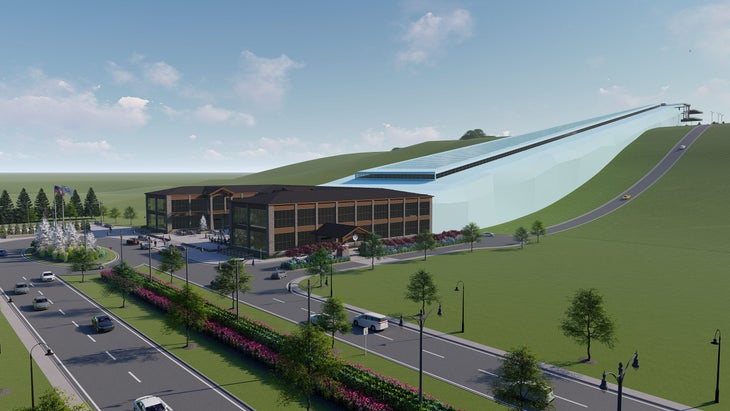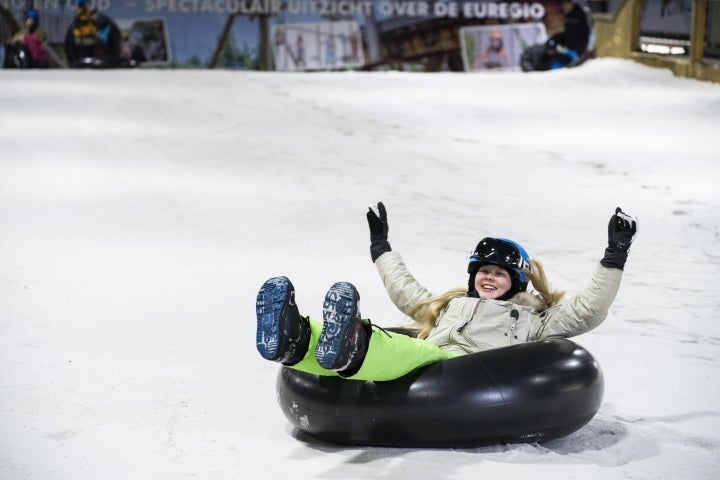Heading out the door? Read this article on the new Outside+ app available now on iOS devices for members! Download the app.
On the long list of things that we skiers deem ourselves to be too cool for, indoor ski domes are pretty high up there. After all, the true joy of the sport lies in doing it outside—views, the wind in your hair, the sun on your face. Did we mention the views?
But what if the snow dome was located right in the middle of an urban center, and what if its goal was to introduce more people—and a more diverse cross-section of the population—to the sport we love?
That’s the goal of a new indoor snowsports complex planned for Fairfax County in northern Virginia, a diverse county a stone’s throw from Washington, D.C. It’s home to a good percentage of affluent Americans, but is also racially and economically diverse.

Fairfax Peak, which is being developed by Virginia-based company Alpine-X, is being conceived as a destination resort, though not the kind that downhill skiers may be accustomed to. A 400,000-square-foot snow dome will anchor the location, which will also feature a 200-room hotel, restaurants, a mountain coaster, tubing hill, zip lines, and a snow-play attraction.
“By being in the community center, not two or three hours away from it, a lot of guests can come out for a couple hours, but they don’t have to make a major commitment,” says Alpine-X CEO John Emery.
Emery has a bit of experience when it comes to these types of resort destination developments. He launched the Great Wolf Lodge brand of waterpark hotels across the country and understands how to bring these large-scale projects to fruition.
“The Great Wolf concept was to build the hotels a few hours away from major population centers so we could capture people for the weekend,” Emery explains, “but that’s where this concept is different. We want this to be for everybody in the community—we’re trying to expand access to skiing and snowboarding, and having this type of location is absolutely key to being successful.”
Also Read: Top 10 Tips From the Professional Ski Instructors of America
That’s also the reason behind Fairfax Peak’s diversification of activities, says Emery. Their target visitors are families and groups of friends who might not ski or board but might be interested to check it out while others in the group go tubing, ride the coaster, or just flop around in the snow.
“We want the entire community to enjoy it, not just people who are focused on snowsports,” Emery says.
Another important facet of the business plan is keeping costs reasonable. Skiing, as we well know, is an expensive pastime, and it’s a big ask of beginners to lay out a bunch of money on something they’re not sure they’re going to enjoy.
That’s why lift tickets will be less expensive than at the nearest regional ski areas, and rentals will be a fraction of the cost. Because Fairfax Peak won’t have to deal with the seasonality of the sport, it can spread its costs out throughout the year. Plus, Emery says, with people coming to ski for a few hours at a time, the facility gets more bang from its buck on equipment and can pass those savings down to the community.
The slopes themselves will be covered in man-made snow 365 days a year, and the dome will be kept at between 25 and 27 degrees. The 10 acres of terrain will be divided by skill level—“our own version of green, blue, and black slopes,” says Emery—and the total vertical drop will be around 300 feet.

The project also has an environmental component. Fairfax Peak will be built on a former landfill—a repurposing of a defunct site that will be fully mitigated, and also provide a bit of natural elevation which will be integrated into the design of the dome.
“The top of our ski dome will sit 60 feet higher than the top of the landfill,” he says, “which helps with construction cost, the look and feel of the facility, and it works out well environmentally. We’re shooting for carbon neutrality and planning lots of solar, because we intend this project to be an example of how a large building doesn’t have to have a big carbon footprint.”
Of course, any talk of an indoor snow dome invites comparison to N.J.’s Big Snow American Dream, the 180,000-square-foot indoor ski hill that opened in December of 2019. The pandemic postponed Emery’s visit to the facility, now rescheduled for the coming months, but the two projects are pretty different, he says.
“We’re aiming for more of the resort experience,” he says, “while Big Snow is more of a day attraction, being part of the mall. But we’re happy that people are liking that experience, it’s confirmation that what we’re planning here can work. Our slopes will be over twice the size, as well.”
And planning they are. Fairfax Peak is one of 20 indoor snowsports facilities that Alpine-X is envisioning. It is scheduled to break ground in around 18 months, and open in late 2024 or early 2025. Another facility is already in the beginning planning stages in another part of the country, the location of which will be shared when they are a little further along into the process.
Related: Finally, a Way to Keep Old Ski Boots Out of the Landfill
The way Alpine-X sees it, Emery explains, is that they are more likely to build near urban areas in say Texas or Florida, places with people who want to experience snowsports, rather than places that already have a high number of dedicated enthusiasts.
As for the local mid-Atlantic ski resorts closest to Fairfax Peak, Emery says that reception to the indoor snow dome concept has been fantastic.
“Listen, skiing is intimidating when you’re not highly skilled,” he says. “When you can introduce something in a more controlled environment, people respond better and are more likely to want to repeat the experience. That’s why the local resorts are excited about Fairfax—they’re hoping it’ll hook more skiers who can get acclimated to the sport with us, creating more people who are comfortable venturing out to them.”
“Our plan is to complement the outdoor experience and feed into it rather than compete with it.”
